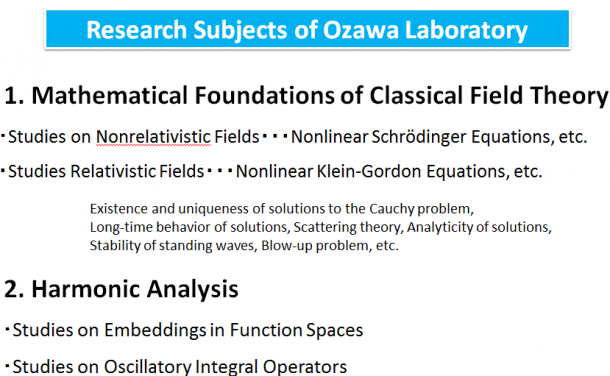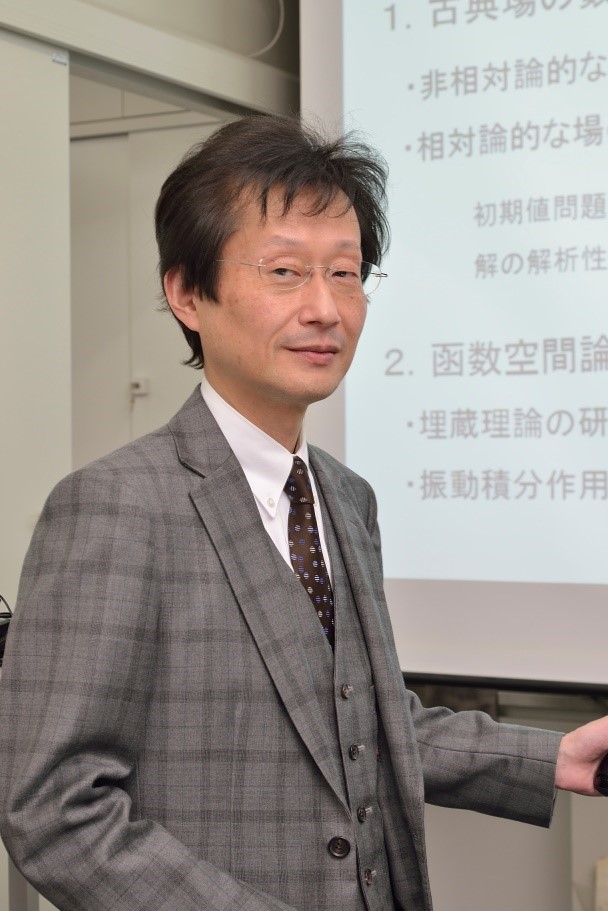Mathematical physics research
Professor Tohru Ozawa, Faculty of Science and Engineering (Department of Applied Physics, School of Advanced Science and Engineering)
The mathematical projection of nature itself – The real thrill of mathematical physics

In February 2016, there were news reports that scientists had observed gravitational waves for the very first time. This was confirmation of the existence of something that Einstein had predicted 100 years ago. Why was Einstein able to predict gravitational waves? It was because he got to the very core of the mathematical structures hidden within the essence of physical phenomena. We heard from Professor Tohru Ozawa of the Faculty of Science and Engineering (Department of Applied Physics, School of Advanced Science and Engineering) about mathematical physics, which attempts to explain physical phenomena with mathematics.
History of mathematical physics research
I am a researcher of mathematical physics. The main research themes at the Ozawa Laboratory are the mathematical foundations of classical theory, quantum mechanics theory, magnetohydrodynamics and plasma physics, hydrodynamics, and nonlinear optics.
Established in 1877, the Tokyo Sugaku Kaisha (Tokyo Mathematical Society) was the earliest academic society in Japan. There were already numerous European academies before then, such as the London Mathematical Society in Britain, but the Tokyo Sugaku Kaisha was formed earlier than the American Mathematical Society. Experts in Japanese mathematics, Western arithmetic, and the study of natural science gathered here. Although natural science brings to mind Yukichi Fukuzawa’s Kyuri Zukai (Illustrated Book of Natural Science), this is what we now refer to as ‘physics.’ The Tokyo Sugaku Kaisha reorganized as the Tokyo Sugaku-Butsurigaku Kwai (Tokyo Mathematical and Physical Society) in 1884, before changing its name to the Nippon Sugaku-Butsurigaku Kwai (Physico-Mathematical Society of Japan) in 1918. After World War 2, it was split into the Mathematical Society of Japan (MSJ) and the Physical Society of Japan.
There are 62 mathematical fields according to Mathematical Reviews published by the current American Mathematical Society. These include mechanics, hydrodynamics, optics, quantum theory, geophysics, and more. There are others too such as game theory, biology, information, circuits, and so on. The significance of this is that it is common practice in the West for all research papers utilizing mathematics to be classified as mathematics. Researchers actively use mathematics as a tool (or you could even say a weapon) in various kinds of research. If you look at the classification table, although numbers have been sequentially allocated from 0 onwards, “08 General algebraic system” is directly followed by “11 Number theory,” skipping 9 and 10. This suggests that new fields may be added in the future.
The Mathematical Physics Laboratory at Waseda University was established in 1929, long before the university established the Department of Physics and Department of Applied Physics. The person who founded the laboratory was Professor Shiro Koizumi, a researcher into circuit theory. Leadership was passed on to Professor Riichi Iino, Professor Masayoshi Tsutsumi, Professor Mitsuharu Otani and then me.

Figure:Subject in Mathematics (Source: 21st Century COE Program :Mathematics of Nonlinear Structure via Singularity)
Mathematics as a discipline for explaining physical phenomena
What is mathematical physics? It can be described as the academic discipline of using mathematics to analyze the basic equations underlying theoretical physics. Almost all physical phenomena are presented in the form of differential equations. Descriptions of physical phenomena start with the derivation of a formula, which involves setting the physical quantity to be investigated (position, speed, acceleration, density, distribution, wave function, field, etc.) and writing an equation that balances its rate of variability (time change, space change, variation, etc.) against power, flow, etc. If differentiation is used to express the rate of variability, that formula becomes a differential equation.
In such a case, however, it should be noted that although the differential equation is a frame of reference based on an actual phenomenon, it is merely a model. Modeling is the process of derivation through simplification of essential parts of an actual phenomenon while completely ignoring and discarding the other comparatively unimportant elements.

Professor Ozawa explains a concept in mathematical physics
For instance, if we think about physical phenomenon that occur before our eyes, the time variable can be interpreted as a real number, but even if measurement techniques improve, it will be impossible to surpass a rational number display. Alternatively, the concept of a mass point in classical mechanics contains mass and position, yet we view position as a dimensionless point. Realistically, there can be no such thing as an object that has mass but no size.
Therefore, a model does not need to be a copy of reality, but should be derived from the simplified essence of a phenomenon and expressed precisely. The moment a model takes on the mathematical appearance of a differential equation, it considered a mathematical object temporarily distinct from the observed phenomenon, and all that remains is the result obtained from mathematical examination. If that result strikes at the essence of the phenomenon, it will become a theoretical explanation for the phenomenon.
Newton’s equations of motion, the Navier-Stokes equations, the Boltzmann equation, Maxwell’s equations, the Schrödinger’s equation, the Dirac equation, and others are typical examples of differential equations. These kinds of established theories are simplified and extremely abstract.
The important thing, therefore, is not that the phenomenon is explained using a differential equation, but that there is a solution to that differential equation. The existence of the phenomenon is equivalent to the existence of a solution to the differential equation in the modeled frame of reference, and we can produce an explanation of the phenomenon by exploring the mathematical nature of that solution. In other words, a differential equation that describes a phenomenon well is one that can mathematically prove and express the existence of a solution and the nature of the solution linked to the phenomenon.
Viewing the world through deep mathematical thought
In physics, there are various kinds of basic equations. We therefore have to consider how they interact with one another. For instance, if you are all alone in your own world, you are not influenced by anything around you. But gravitational waves, for example, are distortions in time and space caused by mass, and those distortions propagate through space-time. Phenomenon with these kinds of interactions are explained using a nonlinear equation, not a linear equation.
A model devised as an example of a phenomenon become temporarily removed from the phenomenon in order to gain a deeper understanding of the essence of the phenomenon and make predictions of theoretically possible new phenomena by freely studying the generalized model in its generalized frame of reference. To put it another way, we can predict new physical phenomena through investigations into mathematics.
This is not something that has just begun, as Mach and Boltzmann were already fiercely debating the kinetic theory of gases 100 years ago, a time when molecules and atoms still had only an invisible presence. Mesons, whose presence was predicted by Dr. Hideki Yukawa, were later proven to exist thanks to advances in observation technology. Now we are in an era when we can even pick up and move electrons, let alone molecules and atoms. Furthermore, we have observed the gravitational waves predicted by Einstein.
As Heidegger proclaimed, nature itself is a projection of mathematics (mathematischen Entwurf der Natur selbst), and people’s act of thinking deeply is in itself a phenomena. As fascinating as it is, this is the condensed thrill of mathematical physics.

- Photo: Professor Ozawa making a speech at the Japan forum of the 2014 International Congress of Mathematicians (ICM) (Source: The Mathematical Society of Japan)
Next time, we feature doctoral student Kazumasa Fujiwara, a favorite pupil of Professor Ozawa’s and winner of Ikushi Prize from the Japan Society for the Promotion of Science (JSPS). He will speak with Professor Ozawa about mathematical physics.
※Ikushi Prize, Japan Society for the Promotion of Science
※Waseda University, Research News
※Waseda University, Research News (Award Ceremony)
Profile
Ozawa graduated from the Department of Physics at Waseda University’s School of Science and Engineering. After withdrawing from the Division of Mathematical Science at Kyoto University’s Graduate School of Science, he obtained his PhD. He was a research associate at Nagoya University’s School of Science and Kyoto University’s Research Institute for Mathematical Sciences, and became a lecturer, assistant professor and professor at Hokkaido University’s Faculty of Science before taking up his current post. Other positions include leader of the “Mathematics of Nonlinear Structures via Singularities” 21st Century COE Program, deputy leader of the Mathematics and Physics Unit “Multiscale Analysis, Modeling and Simulation” initiative as part of the Top Global University Project, Waseda University, and chair of the Japanese committee of the International Mathematical Union (IMU). He won the MSJ Spring Prize from the Mathematical Society of Japan.
Accomplishments and research
- J. Kato, T. Ozawa,Endpoint Strichartz estimates for the Klein-Gordon equation in two space dimensions and some applications, J. Math. Pures Appl., 95(2011), 48-71.
- S. Katayama, T. Ozawa, H. Sunagawa,A note on the null condition for quadratic nonlinear Klein-Gordon systems in two space dimensions,Commun. Pure Appl. Math., 65(2012), 1285-1302.
- N. Hayashi, T. Ozawa, K. Tanaka,On a system of nonlinear Schrödinger equations with quadratic interaction,Ann. Inst. Henri Poincaré, Analyse non linéaire, 30(2013), 661-690.
- T. Ozawa, K. Rogers,A sharp bilinear estimate for the Klein-Gordon equation in ℝ1+1,Int. Math. Res. Not. IMRN, 2014(2014), 1367-1378.DOI:10.1093/imrn/rns254
- R. Carles, T. Ozawa,Finite time extinction for nonlinear Schrödinger equation in 1D and 2D,Commun. PDE., 40(2015), 897-917.DOI:10.1080/03605302.2014.96735










